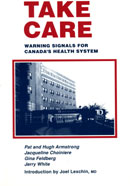
Take Care
Warning Signals for Canada's Health System
Armstrong, Hugh, Armstrong, Pat, Choiniere, Jacqueline, Feldberg, Gina, White, Jerry
Publisher: Garamond, Toronto, Canada
Year Published: 1994
Pages: 127pp ISBN: 1-920059-23-6
Library of Congress Number: RA395.C3A7 1994 Dewey: 362.1'0971
Resource Type: Book
Cx Number: CX6596
"Examines the modern Canadian health care system and exposes the impact of neo-conservative and market-oriented policies, showing the effect these have on patients and caregivers, particularly women. The voices of hospital workers, relating their own daily experiences in the wards, add a poignant urgency to the crucial question: What kind of health care system will Canadians inherit in the twenty-first century?"
Abstract:
The articles in this book examine the effect of an increasingly market-oriented health care system on patients, staff and caregivers. Previous histories of Canadian health care have focused on legislation and politics; this study is concerned with workers and their unions. Because without the energy and vision of the labour movement, argues Lexchin in his introduction, "Canada wouldn't have its much vaunted health care programs."
Increasingly, decisions in Canadian health care are being made on a market-first, rather than patient-first, approach. The book looks at the effect of this change--including the resulting cutbacks in funding--on those who do the bulk of the work: nursing assistants, orderlies, cleaners etc. In general, the authors find that the changes have had a profoundly negative effect on the quality of working life, and therefore on the care that patients receive. It unpicks the myth of a "crisis" in health care, arguing that Canadian spending on health care is increasing at a sustainable rate. The chapter entitled "Voices from the Ward" uses direct quotes from several focus-group studies and draws out common themes. It concludes that "new managerial strategies threaten the health of employees as well as patients." "Closer to Home" examines the effect of promoting home and community care. It reveals that little attention is paid to the needs of the women who provide this (often unpaid) care. In White's closing essay, he concludes that the group's research has shown that cuts in funding and initiatives must be monitored in relation to their effect on the institution's workers, the patient, and the environments of those institutions. Includes a bibliography but no index.
[Abstract by Alice Lawlor]
Subject Headings


